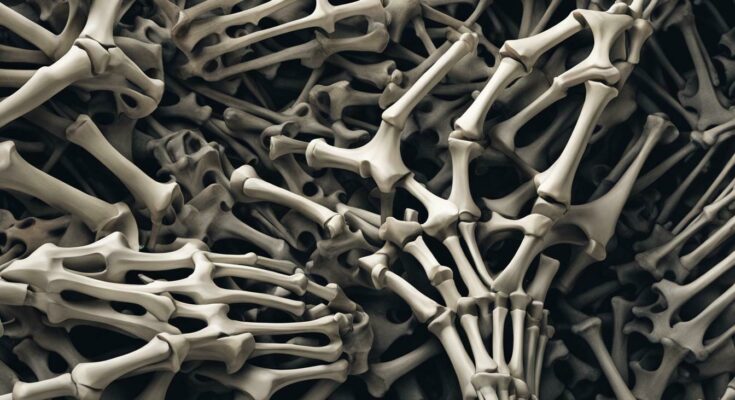Have you ever wondered how your joints move so seamlessly? How your bones fit together like puzzle pieces to provide stability and support? The answer lies in the concept of overlapping bones.
Overlapping bones are essential components of the skeletal system. They allow for joint movement and provide the foundation for our every movement.
In this article, we’ll delve into the intricate bone structures and the intricate connections that allow for joint movement. We’ll explore the significance of overlapping bones in the human body and how they contribute to overall bone structure and joint anatomy in the skeletal system.
Key Takeaways:
- Overlapping bones play a crucial role in joint movement and stability
- The skeletal system is composed of various types of bones that work together to support the body
- Understanding the anatomy of joints and bone alignment is crucial for preventing injuries
- The mechanics of bone overlap enable coordinated and smooth joint movement
- Appreciating the significance of overlapping bones can help us understand the remarkable complexity of the human body
Understanding the Skeletal System
The skeletal system is one of the most remarkable systems in the human body, providing structural support, protection to internal organs, and enabling movement.
Composed of 206 bones, the skeletal system functions as a complex network that supports and maintains our body shape. These bones vary in size and shape, but they all possess a similar internal structure, consisting of strong, mineralized tissue.
Bones are classified into five types based on their shape and function: long, short, flat, irregular, and sesamoid bones. All bones contain two main types of tissue, compact and spongy bone tissue. The compact bone is dense and hard, while the spongy bone is porous and lightweight, providing support and flexibility.
The skeletal system is also responsible for producing blood cells, housing the bone marrow, which generates red and white blood cells, and platelets, required for clotting.
Every bone in our body is interconnected to create a complex network of bone structures that form the skeletal system. These bones provide protection and support to the body’s organs and tissues, allowing us to move and carry out physical activities.
The skeletal system interacts with other systems within the body, including the muscular, nervous, and circulatory systems, to ensure the body functions smoothly and effectively.
The overlapping bones within the skeletal system play an essential role in the alignment of joints and overall stability of the body. In the next section, we will explore the anatomy of joints in greater detail, examining the interactions and connections between overlapping bones that enable joint movement.
The Anatomy of Joints
Understanding joint anatomy is crucial to comprehending the significance of overlapping bones. Joints, also known as articulations, are the areas where two or more bones meet. There are several types of joints, including fixed, semimovable, and movable joints.
Movable joints are the most common in the body and allow for a wide range of movement. They consist of two or more bones that are connected by ligaments, allowing for flexibility and mobility. The ends of the bones in a joint are covered by a layer of cartilage, which helps to reduce friction and absorb shock.
The overall structure of a joint is essential for proper joint function. The shape of the bones and how they fit together determine the type of movement that is possible. For example, a hinge joint, like the knee, only allows for flexion and extension, whereas a ball and socket joint, like the hip, allows for a more extensive range of motion in multiple directions.
Types of Joints
There are six main types of joints:
- Hinge Joints: These joints allow for movement in one direction, like the knees and elbows.
- Pivot Joints: These joints allow for rotation, like the neck.
- Ball and Socket Joints: These joints allow for movement in multiple directions, like the hips and shoulders.
- Saddle Joints: These joints enable movement in two directions, like the thumbs.
- Condyloid Joints: These joints allow for movement in multiple directions, but with limited rotation, like the jaw.
- Glide Joints: These joints allow for sliding movements, like those between the vertebrae in the spine.
The anatomy of joints can vary depending on the specific joint and its location in the body. However, all joints contain synovial fluid, which lubricates the joint and helps to reduce friction, as well as a joint capsule, which holds the joint together.
Understanding the anatomy of joints and their role in facilitating movement is central to comprehending the importance of overlapping bones in the skeletal system. The next section will focus on the significance of proper bone alignment in joint function.
Exploring Bone Alignment
Proper bone alignment is crucial for optimal joint function. Bones that are out of alignment can lead to instability, discomfort, and even injury. The skeletal system relies on overlapping bones to maintain alignment, ensuring that each joint can move smoothly and without restriction.
When bones overlap, they create a stable framework that supports the body’s weight and allows for movement. This is particularly important in weight-bearing joints such as the hips, knees, and ankles. Overlapping bones work together to maintain joint stability and prevent excessive movement that could lead to injury.
The skeletal system is also designed to accommodate changes in bone alignment. For example, during growth spurts in children or after injury, bones can shift, and the skeletal system will adjust to maintain proper alignment. This is possible because overlapping bones allow for some flexibility in joint movement while maintaining stability.
In addition to maintaining alignment, overlapping bones also play a crucial role in joint health. When bones are properly aligned, they distribute forces evenly across the joint, reducing the risk of wear and tear on the cartilage and other soft tissues. This helps to prevent conditions such as osteoarthritis, which can arise from prolonged wear and tear on the joint.
Preventing Bone Misalignment
To maintain proper bone alignment, it’s essential to maintain good posture, exercise regularly, and avoid activities that put undue stress on the joints. For example, high-impact activities such as running or jumping can place a lot of stress on the joints and increase the risk of misalignment or injury.
It’s also essential to wear appropriate footwear that provides adequate support and cushioning. Poorly fitting shoes or shoes that lack sufficient support can alter the alignment of the foot and ankle, leading to misalignment throughout the body.
Lastly, if you’re experiencing joint pain or discomfort, seek medical attention. Addressing the issue early can help prevent further damage and restore proper alignment to the affected joint.
In conclusion, overlapping bones play a critical role in maintaining bone alignment and joint health. By ensuring proper alignment, we can reduce the risk of joint pain, injury, and conditions such as osteoarthritis. The skeletal system is a remarkable structure that relies on the intricate interactions between overlapping bones to provide stability, flexibility, and support for the body.
The Mechanics of Bone Overlap
When bones overlap, they come into contact with one another and work together to provide support and structure to the body. This interaction is crucial in facilitating joint movement and allowing us to perform various activities and tasks.
The mechanics of bone overlap are intricate and complex. When bones overlap, they do not simply touch each other. Instead, they interlock, forming a joint that allows for movement. The surfaces of the bones that come into contact with each other are covered with a layer of cartilage, which provides cushioning and reduces friction between the bones.
When a joint moves, the overlapping bones glide over each other, guided by ligaments and muscles that surround the joint. These ligaments and muscles work together to provide stability and control to the joint, ensuring that the bones move smoothly and in the correct direction.
Bone overlap is also crucial in maintaining joint alignment. When bones overlap properly, they provide support to each other and help distribute weight and pressure evenly across the joint. This helps prevent injuries and ensures that the joint functions properly.
Overall, the mechanics of bone overlap are a critical component of joint movement and function. Through their intricate interactions, overlapping bones provide the support and structure necessary for the body to perform a wide range of activities, from walking and running to more complex movements like dancing and athletics.
Overlapping Joint Movement
Overlapping bones play a crucial role in facilitating joint movement. Through their unique connection and alignment, they enable a wide range of motion that allows us to perform various activities and tasks.
When we move our joints, the overlapping bones interact with each other, gliding and rotating in a coordinated manner. This movement is made possible by the relationship between bone shape and joint function. The shape of the bones has evolved to allow for efficient movement, while the joints have evolved to accommodate these shapes.
Overlapping joint movement is particularly important for activities that require precise coordination, such as typing or playing a musical instrument. In these cases, the bones must work together in a highly specific way to achieve the desired result.
The bone connection in overlapping joints is also crucial for joint stability. By maintaining proper bone alignment, we can prevent injuries and promote healthy joint function. When bones are misaligned, they may rub against each other, causing friction and leading to wear and tear over time. This can ultimately result in joint damage and pain.
Overall, overlapping bones play a vital role in joint movement and stability. By understanding their mechanics and interactions, we can appreciate the remarkable complexity and resilience of the human body.
Conclusion
In conclusion, our understanding of the skeletal system and joint anatomy has been greatly enhanced by exploring the concept of overlapping bones. We have seen how these bones play a crucial role in maintaining joint stability and enabling smooth and coordinated movement.
By appreciating the mechanics of bone overlap and bone alignment, we can gain a deeper understanding of how the skeletal system functions. This knowledge not only helps us appreciate the remarkable complexity and resilience of the human body, but it also helps us prevent injuries and maintain our skeletal health.
Enhancing Joint Overlap
To enhance joint overlap and optimize skeletal function, it is important to maintain a healthy lifestyle that includes proper nutrition, regular exercise, and adequate rest. Avoiding bad habits such as poor posture and excessive stress on joints is also crucial.
In addition, consulting with professionals such as physical therapists and orthopedic specialists can provide valuable insights into ways to enhance joint overlap and promote overall skeletal health. By taking a proactive approach to our skeletal health, we can ensure that our bodies remain strong and resilient for years to come.
So, let’s continue to unravel the mystery of overlapping bones and explore the remarkable complexity of the skeletal system. Let us harness this knowledge to optimize our skeletal health and lead healthy, active lives.
FAQ
Q: What are overlapping bones?
A: Overlapping bones refer to the arrangement of bones in the body where one bone partially or fully covers another bone. This overlapping structure plays a vital role in joint movement and stability.
Q: What is the significance of overlapping bones in the skeletal system?
A: Overlapping bones are crucial for the proper functioning of the skeletal system. They provide stability and support to joints, allowing for smooth and coordinated movement. Without overlapping bones, joint function would be compromised.
Q: How do overlapping bones contribute to joint alignment?
A: Overlapping bones help in maintaining proper joint alignment by providing additional stability and preventing dislocation. They work in conjunction with ligaments, tendons, and muscles to ensure that joints stay aligned during movement.
Q: Do all joints in the body have overlapping bones?
A: No, not all joints have overlapping bones. The presence of overlapping bones depends on the type of joint and its range of motion. Some joints, like pivot joints, have a minimal overlap, while others, like ball-and-socket joints, have a significant amount of overlapping bones.
Q: Can overlapping bones prevent injuries?
A: Yes, overlapping bones play a crucial role in preventing injuries. By providing stability and support to joints, they help absorb and distribute forces during movement, reducing the risk of excessive stress on individual bones or joints.
Q: How do overlapping bones enable joint movement?
A: Overlapping bones facilitate joint movement by interacting with each other through specialized structures called articulations. These articulations allow bones to glide, rotate, and pivot, enabling a wide range of motion in joints.
Q: Are overlapping bones unique to humans?
A: No, overlapping bones are not unique to humans. They are found in various vertebrates, including mammals, birds, reptiles, and amphibians. Overlapping bones have evolved as a structural adaptation to enhance mobility and stability in these organisms.




